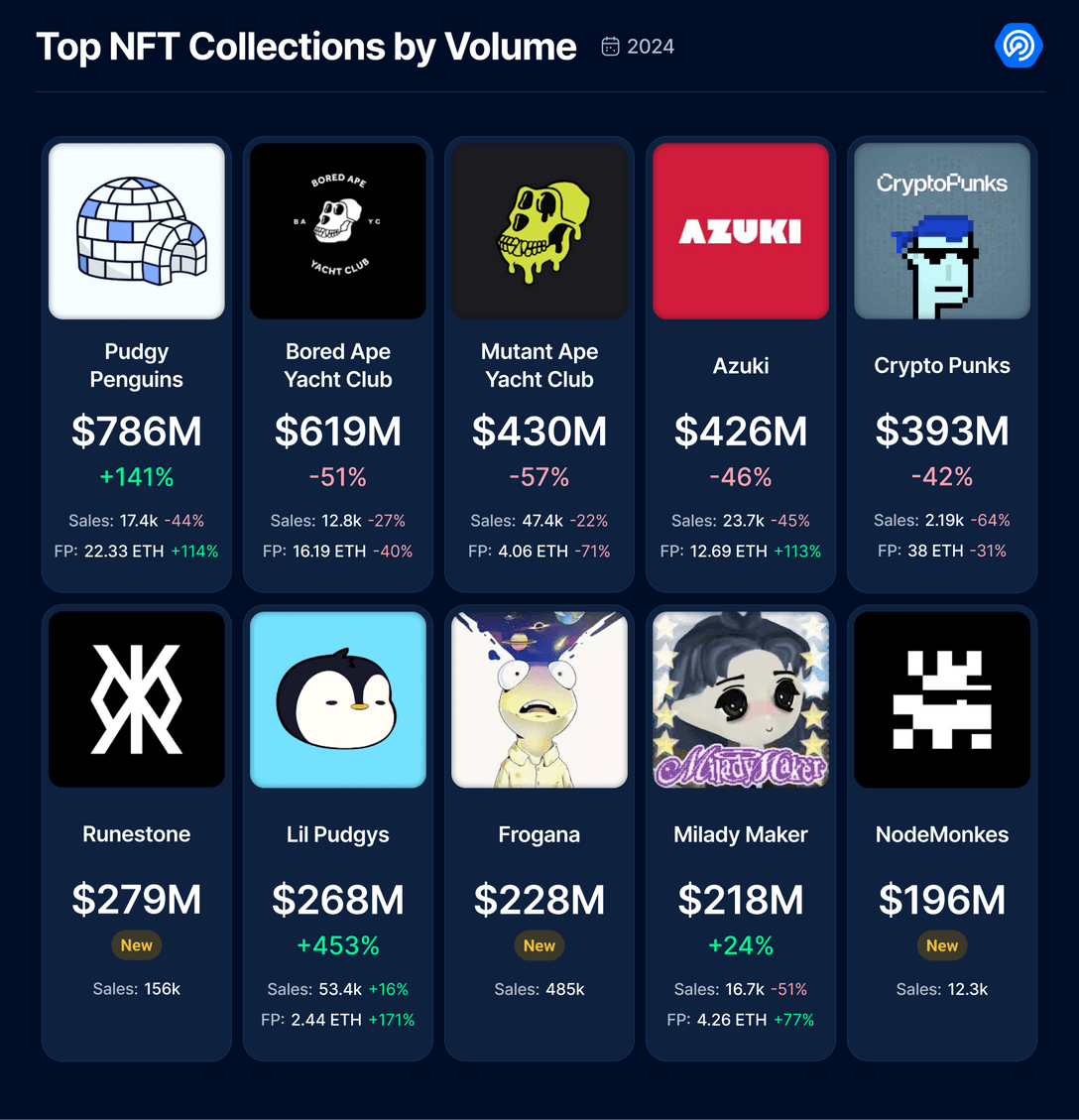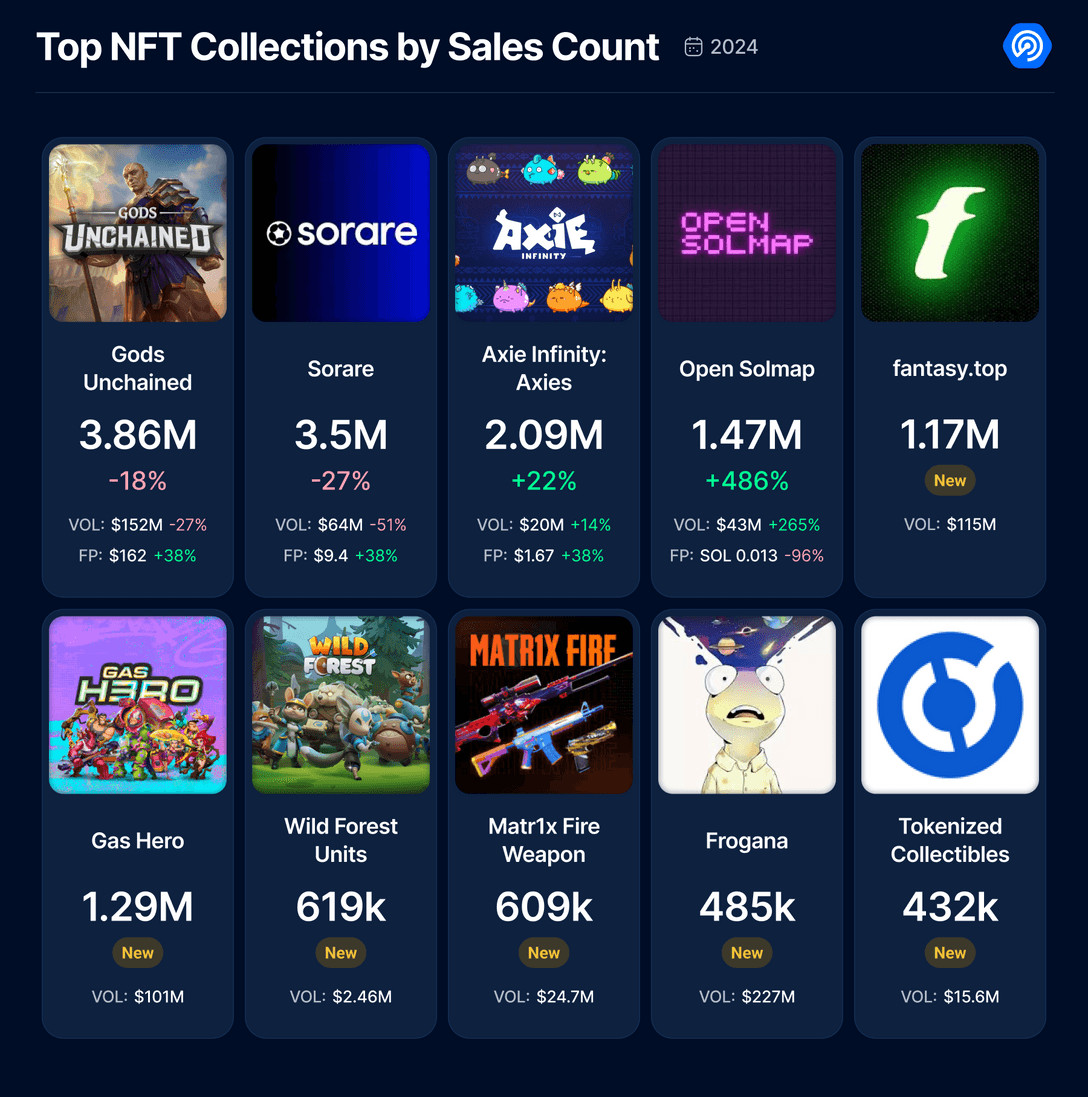The NFT marketplace is grappling with significant challenges in 2024 as unpredictable market conditions disrupt trading activities and sales trends.
In Brief
The year 2024 proved to be quite tumultuous for the NFT sector, witnessing substantial fluctuations in both trading volumes and sales figures. It became one of the most challenging years for NFTs since 2020.

With considerable fluctuations in both trading activities and sales numbers, 2024 marked a period of upheaval for the NFT marketplace. Even though it kicked off with a promising outlook at the year's start, the market faced significant adversity as the months progressed, resulting in one of the poorest performances since 2020. Overall, NFT performance reflected the wider instability in the digital asset landscape, though some notable advancements and increased utilization within certain sectors were observed. according to DappRadar The year commenced on a positive note with trading volumes surging, achieving nearly $5.3 billion in Q1—up 4% from the same period in 2023. This impressive start was fueled by rising interest in digital collectibles and a broader integration of blockchain technology across various industries. After experiencing a downturn in previous years, NFTs seemed ready for a formidable comeback in the initial months of 2024.
Early Optimism: A Good Start for 2024
Mid-Year Challenges: Setbacks in Q2 and Q3
As the year progressed, initial optimism soon dwindled. By the third quarter of 2024, NFT trading volumes plummeted to just about $1.5 billion, indicating a dramatic loss of momentum in the market. This sharp decline can be attributed to various factors, including shifting investor sentiments, regulatory ambiguities, and overarching economic strains.
Though trading volumes languished in Q3, a minor rebound occurred in Q4, raising volumes to $2.6 billion. However, this recovery was insufficient to compensate for the pronounced losses earlier in the year, leading to an overall trajectory indicating a struggling market, where trading activities failed to reach the highs recorded in preceding years.
NFT Collections: New Dynamics and Collaborations

Photo: DappRadar
In 2024, the landscape of leading NFT collections underwent notable transformations. The performance of Pudgy Penguins stood out remarkably. Even though it ranked among the high performers in trading volume, this collection faced a stark 44% drop in sales when compared to the previous year. Interestingly, despite this decline, the floor price of Pudgy Penguins surged by 114%, suggesting a trend towards fewer but more valuable transactions.
The success of Pudgy Penguins in 2024 can largely be attributed to their strategic efforts to extend their reach beyond the online space. They boosted their visibility in the physical world by launching plush toys in prominent retailers like Walmart, Walgreens, Target, Selfridges, and Argos across the UK.

Photo: DappRadar
In May 2024, Pudgy Penguins partnered with Mythical Games to create a blockchain-based mobile game featuring their iconic penguin characters. This collaboration aimed to integrate them into a high-quality gaming experience, reflecting the growing trend of NFTs serving functional purposes. Additionally, in September 2024, Pudgy Penguins took a pioneering step as the first profile picture (PFP) NFT collection to feature on the kit of a professional football team, CD Castellón from Spain.
Conversely, Yuga Labs, which has long been a dominant player in the NFT realm, experienced a dip in both floor prices and trading volumes in 2024. Despite a reduction in its overall market dominance, Yuga Labs continued to maintain a strong presence as one of the most frequently traded collections.
Yuga Labs remains committed to innovation with plans for its immersive metaverse project, Otherside, and an upcoming collaboration with PP Man set for 2025. Their determination to revitalize their market position is evident in their strategic pursuits to expand their offerings and explore new avenues within the metaverse.
The Gaming Sector: Paving the Way for NFTs’ Future

Photo: DappRadar
In 2024, the gaming industry experienced consistent growth. The intersection of NFTs with gaming became increasingly popular, as these digital assets allowed players true ownership of in-game items while participating in player-driven economies. NFTs with in-game utility saw a surge in demand, highlighting their prominent role in gaming sales. This shift indicated a broader market transformation, where NFTs were becoming coveted entities in both virtual settings and gaming ecosystems.
Looking forward, it's anticipated that the gaming sector's adoption of NFTs will continue to escalate. The integration of blockchain into gaming unlocks new potential for players and developers alike, enhancing the gaming experience and creating fresh revenue avenues. As this trend evolves, NFTs in the gaming sphere are poised to gain more significance, ushering in innovations that will shape the future of digital assets.
OpenSea vs. Blur: The Marketplace Rivalry

Photo: DappRadar
In 2024, Blur emerged as a leader in the NFT marketplace, holding the top position for the majority of the year. The platform's success can be largely attributed to its zero-fee trading model, which attracted users keen to reduce costs. Furthermore, Blur implemented several airdrop strategies to enhance user engagement and visibility.
However, it was a challenging year for OpenSea, the previously established frontrunner in the NFT landscape. The U.S. Securities and Exchange Commission (SEC) issued a Wells Notice to OpenSea in August 2024 over alleged unregistered securities. A combination of dwindling market conditions, fierce competition, and regulatory pressures forced OpenSea to announce significant layoffs in November, eliminating 56% of its workforce. In an effort to reclaim its market standing, OpenSea shared plans to launch a revamped version of its platform, “OpenSea 2.0,” in addition to hinting at a potential token release aimed at creating new opportunities for its creators and collectors.
In 2024, Magic Eden—initially focused on the Solana blockchain—outperformed OpenSea, expanding its offerings to include Bitcoin, Ethereum, and Polygon, as well as newer networks like Base and Arbitrum. To strengthen its ecosystem, Magic Eden launched its proprietary ME token in December 2024, accompanied by a significant $700 million airdrop. This strategic move positions Magic Eden firmly within the competitive landscape, possibly shifting the power dynamics in the NFT market.

Photo: DappRadar
In 2024, the NFT ecosystem continued to evolve, moving beyond just collections and marketplaces. A key trend was the diversification of NFT applications across sectors such as gaming, music, real estate, and ticket sales, while digital art and collectibles remained focal points. The expanding utilization of NFTs across various industries illustrated their capacity to provide tangible benefits beyond the digital realm.
It's essential to note that the information presented here is not intended to serve as legal, financial, or investment advice. Always invest only what you can afford to lose and seek independent financial advice if you're uncertain. For further details, please refer to the terms and conditions, along with the support resources provided by the issuer or advertiser. MetaversePost strives for accurate and impartial reporting, but keep in mind that market conditions may change without notice.
Disclaimer
In line with the Trust Project guidelines Victoria is a versatile writer who covers a range of tech topics, including Web 3.0, artificial intelligence, and cryptocurrencies. Her extensive background enables her to produce thoughtful articles that resonate with a broader audience.







